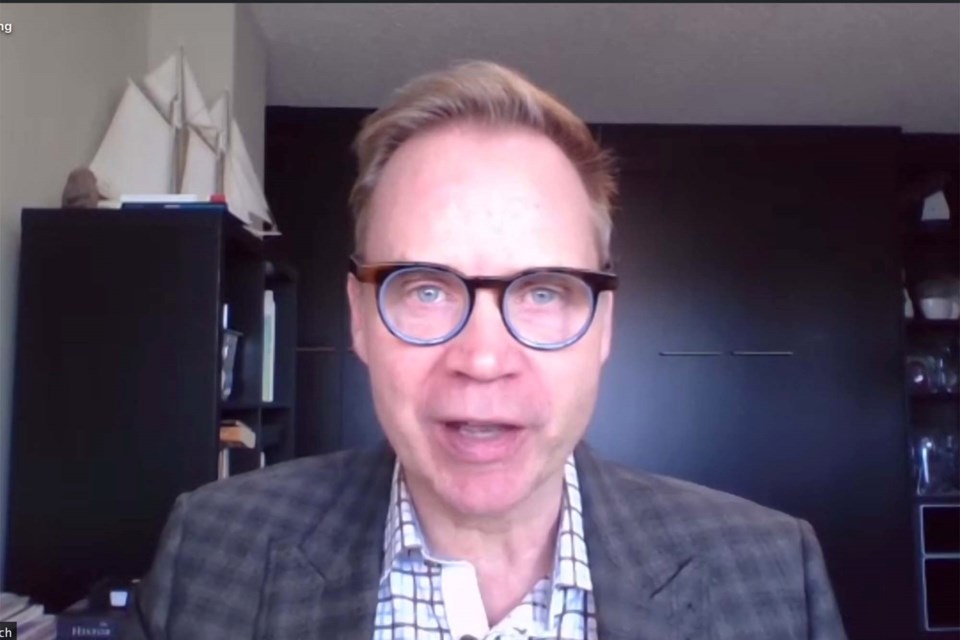The economic forecast for Alberta might be rosy, but Alberta has come from a dark a place, an expert told St. Albert's chamber last week.
“We have been climbing our way out of a very deep hole,” said Todd Hirsch, vice-president and chief economist with ATB Financial during a virtual St. Albert and District Chamber of Commerce event on Feb. 9.
Hirsch said it is expected Alberta’s real GDP growth for this year will be four per cent, followed by 2.5 per cent in 2023.
“Those rates of growth are pretty good,” said Hirsch
Hirsch said the numbers for 2021 aren’t finalized yet, but Alberta had a pretty good rebound year. The real GDP grew about 6.1 per cent, but that has to be put in context. In 2020 the economy contracted by eight per cent, he said, “The single greatest year of economic contraction Alberta has ever experienced.”
The economy showed two-and-a-half years of no growth, and it will take until about the middle of this year for Alberta’s economy to recuperate to the same level it was in February of 2020, said Hirsch.
Hirsch said the unemployment rate in Alberta is likely to stay at about seven to 7.5 per cent for a couple of years before it will reach “a more balanced five per cent.”
“Simply because we've got a lot of excess labour that still needs to be absorbed, even with new jobs being created,” he said.
Hirsch said the province is seeing a lot of growth in many different sectors, including technology, agri-foods, and renewable and clean-energy technology.
Despite growth in those areas, these sectors are still being dwarfed by the traditional oil and gas sector, said Hirsch.
“We're not expecting a lot of growth, particularly in employment in our traditional energy sector. Those energy companies are going to be spending some of that additional revenue they're collecting towards paying off some debt and repairing some balance sheets,” he said.
Despite the rosy forecast and the deep hole Alberta seems to be climbing out of, Hirsch said there are still a couple of risks Albertans need to keep in mind. The first is we are still dealing with Omicron.
“If there's one thing that COVID has taught us, [it] is that it is an unpredictable kind of virus,” he said, adding the province's announcement last week will encourage a lot of businesses, particularly small ones, but he remains cautious.
Possible geopolitical events around the world are another area of risk, said Hirsch.
“Any time there is military combat or even threat of it, it does tend to wobble stock markets. That tends to be a net negative for economies,” he said.
However, the current situation between the Ukraine and Russia could be a net positive for oil prices.
“Russia being one of the world's major oil producers … any disruption … would drive those oil prices certainly above $100 a barrel. The fact that tensions are building right now is likely one of the reasons why oil is at $90 a barrel,” he said.
Hirsch said while that spells good news for Alberta in the short term, it's not something to celebrate.
“All those short-term spikes in oil prices do is create a starboard downside when these oil prices are to correct. And it also means higher prices for energy and for fuel, which also hurt Alberta consumers,” he said.
Hirsch spoke about wanting to change how Albertans think about recovery in the province and the economy.
Hirsch listed three narratives he would like to challenge.
The first: the idea that resources are our source of wealth.
“It's not the oil and gas molecules that make us wealthy. It is the labour, the productivity, and creative ideas that over the decades have been applied in our resource sector. That is [a source of] our wealth,” he said.
The second: that the traditional way of looking at the labour market as a simple linear trade-off between income and leisure has broken down.
“Our relationship with our jobs and our work has changed. Fundamentally, it's no longer just about the paycheque and about income, although that does remain important. But I think as we move forward, what's going to matter to workers is flexibility. Does the employer offer me the kinds of flexibility I might need?” he said.
The third: that inflation will drive interest rates up. Hirsch said in 2022 that narrative breaks down, as inflation is being driven by the supply chain collapsing, crop failures, the idea that higher wages are driving up price, and the idea that pent up consumer demand is driving up demand for goods and services.
Hirsch said it's time to rethink the idea that higher inflation will be dealt with through higher interest rates, because inflation in 2022 is complicated.
Hirsch said that although inflation rates will be higher this year, “the Bank of Canada may be reacting less aggressively than at other points in the past.”




